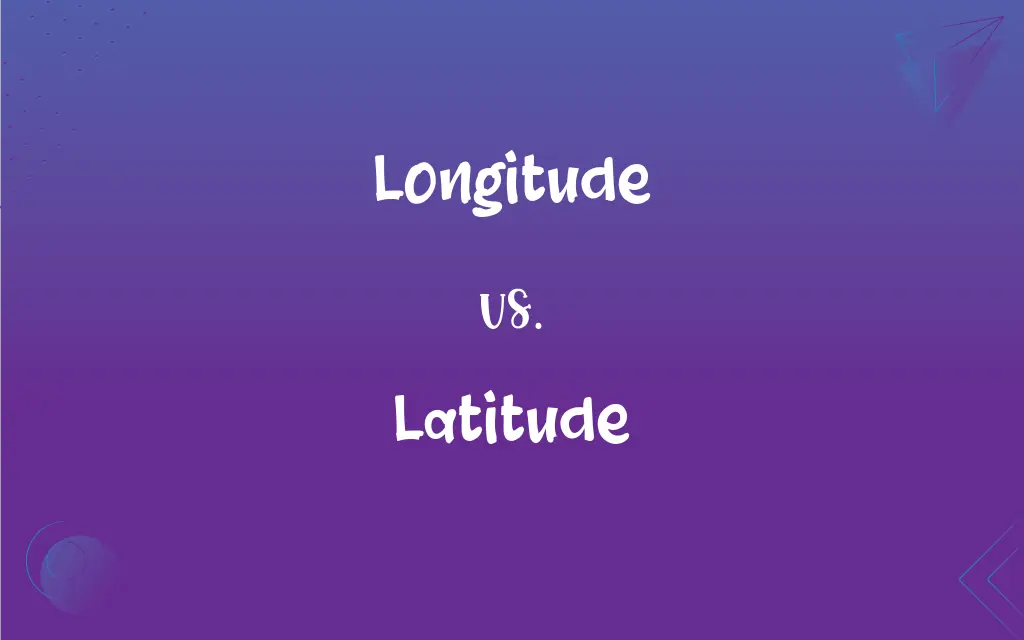Longitude vs. Latitude: What's the Difference?
Edited by Aimie Carlson || By Harlon Moss || Updated on October 13, 2023
Latitude refers to horizontal lines on the globe, measured from the equator, while longitude refers to vertical lines, measured from the Prime Meridian.

Key Differences
Longitude represents the angular distance measured east or west of the Prime Meridian. Latitude, conversely, indicates the angular distance measured north or south from the equator. Both are imaginary lines that crisscross the earth, aiding in navigation and pinpointing locations.
Latitude lines, often referred to as parallels, run horizontally around the Earth. Longitude lines, or meridians, intersect these horizontally, running vertically from pole to pole. These two networks of lines enable us to navigate and locate places on the Earth's surface with precision.
In the context of Earth’s measurement, latitude denotes the warm and cold zones. When thinking of temperature, we often refer to a place’s latitude; equatorial regions are warmer, while moving away from the equator – either north or south - tends to be cooler. Longitude does not affect climate or temperature zones but is vital for timekeeping purposes.
Latitude lines are equidistant from each other, maintaining a consistent separation throughout. In contrast, longitude lines are furthest apart at the equator and converge at the poles, displaying a variable distance that depends on the geographical location.
Latitude gives us our climatic zones: the tropics, temperate, and polar regions. Navigators and geographers utilize the information from lines of latitude to predict weather patterns and understand biomes. In contrast, lines of longitude are instrumental in navigation and determining time zones, as the Earth is divided into 24 time zones, each one covering 15 degrees of longitude.
ADVERTISEMENT
Comparison Chart
Orientation
Vertical lines
Horizontal lines
Reference Line
Measured from the Prime Meridian
Measured from the Equator
Distance Between Lines
Converge at poles
Equidistant
Impact on Climate
No direct impact
Determines climate zones
Impact on Time
Divides Earth into time zones
No impact on time
ADVERTISEMENT
Longitude and Latitude Definitions
Longitude
Longitude denotes vertical lines on a map, measuring east or west from the Prime Meridian.
London is situated close to the Prime Meridian, hence has a longitude of approximately 0 degrees.
Latitude
In geography, lines of latitude are often called parallels due to their equidistant separation.
The 45th parallel North runs through several countries, including Italy and the United States.
Longitude
The longitude of a location can be depicted as either east or west up to 180 degrees.
New York is located at approximately 74 degrees west longitude, on the other side of the Prime Meridian from London.
Latitude
Latitude refers to the horizontal lines encircling the Earth, parallel to the equator.
Singapore, being near the equator, has a latitude of about 1 degree North.
Longitude
In navigation, longitude helps sailors and pilots determine their precise east-west position.
The captain checked the longitude to ensure the ship was on the correct eastward course.
Latitude
Latitude measures the angular distance of a point north or south from the equator.
Oslo, Norway, is located at a latitude of approximately 60 degrees North, indicating its substantial distance from the equator.
Longitude
Lines of longitude are known as meridians, converging at the north and south poles.
The 180th meridian is opposite the Prime Meridian and influences the International Date Line.
Latitude
Latitude is crucial for indicating climatic zones, such as tropical, temperate, and polar regions.
The Arctic Circle, defined by a latitude of approximately 66.5 degrees North, marks the boundary of the polar day and polar night.
Longitude
Longitude is vital in determining time zones, as each 15-degree interval represents a different one.
When you travel across several lines of longitude, you may need to adjust your watch to the new time zone.
Latitude
Latitude can significantly influence the climate and biodiversity of a region.
Colombia, located close to the equator, has a low latitude and is characterized by a tropical climate.
Longitude
Angular distance on the earth's surface, measured east or west from the Prime Meridian at Greenwich, England, to the meridian passing through a position, expressed in degrees (or hours), minutes, and seconds.
Latitude
The angular distance north or south of the earth's equator, measured in degrees along a meridian, as on a map or globe.
Longitude
Celestial longitude.
Latitude
A region of the earth considered in relation to its distance from the equator:temperate latitudes.
FAQs
How is longitude represented?
Longitude is also represented in degrees (°), with values ranging from +180° to -180°.
Where is the starting point for measuring latitude?
The equator is the starting point, with a latitude of 0°.
What is longitude?
Longitude is the measurement of distance east or west of the Prime Meridian.
Where is the starting point for measuring longitude?
The Prime Meridian in Greenwich, England, is the starting point, with a longitude of 0°.
What is the purpose of longitude?
Longitude helps to calculate time zones and assists in pinpointing locations east or west globally.
What is latitude?
Latitude is the measurement of distance north or south of the equator.
What is the purpose of latitude?
Latitude helps determine climatic zones and aids in locating places north or south on the Earth's surface.
What are meridians?
Meridians refer to lines of longitude.
How does latitude affect biodiversity?
Latitude can influence the amount of sunlight, thus affecting temperature and habitats, which subsequently impacts biodiversity.
How is latitude represented?
Latitude is represented in degrees (°), with values ranging from +90° to -90°.
What is the highest degree of longitude?
The highest degree of longitude is 180°, found in the International Date Line.
Why is latitude important to climate?
Latitude influences temperature and weather patterns, affecting the overall climate of a region.
How does longitude affect time zones?
Every 15° longitude represents a new time zone, as the Earth is divided into 24 of them.
Can a place have the same latitude and longitude?
No, since latitude and longitude measure different geographical aspects (north-south and east-west, respectively).
Why are there 360 degrees of longitude?
There are 360° of longitude as it represents the Earth's rotation and the geometric division of circles.
What is the highest degree of latitude?
The highest degree of latitude is 90°, found at the North and South Poles.
What are parallels?
Parallels are another name for lines of latitude.
Is 0° latitude the same everywhere on Earth?
Yes, 0° latitude is consistently the equator, encircling the Earth equidistant from the poles.
How many main lines of latitude are there?
There are 5 main lines of latitude: the equator, Tropic of Cancer, Tropic of Capricorn, Arctic Circle, and Antarctic Circle.
How are longitude and latitude used together?
Longitude and latitude are used together to specify the precise location of a point on the Earth’s surface.
About Author
Written by
Harlon MossHarlon is a seasoned quality moderator and accomplished content writer for Difference Wiki. An alumnus of the prestigious University of California, he earned his degree in Computer Science. Leveraging his academic background, Harlon brings a meticulous and informed perspective to his work, ensuring content accuracy and excellence.
Edited by
Aimie CarlsonAimie Carlson, holding a master's degree in English literature, is a fervent English language enthusiast. She lends her writing talents to Difference Wiki, a prominent website that specializes in comparisons, offering readers insightful analyses that both captivate and inform.































































